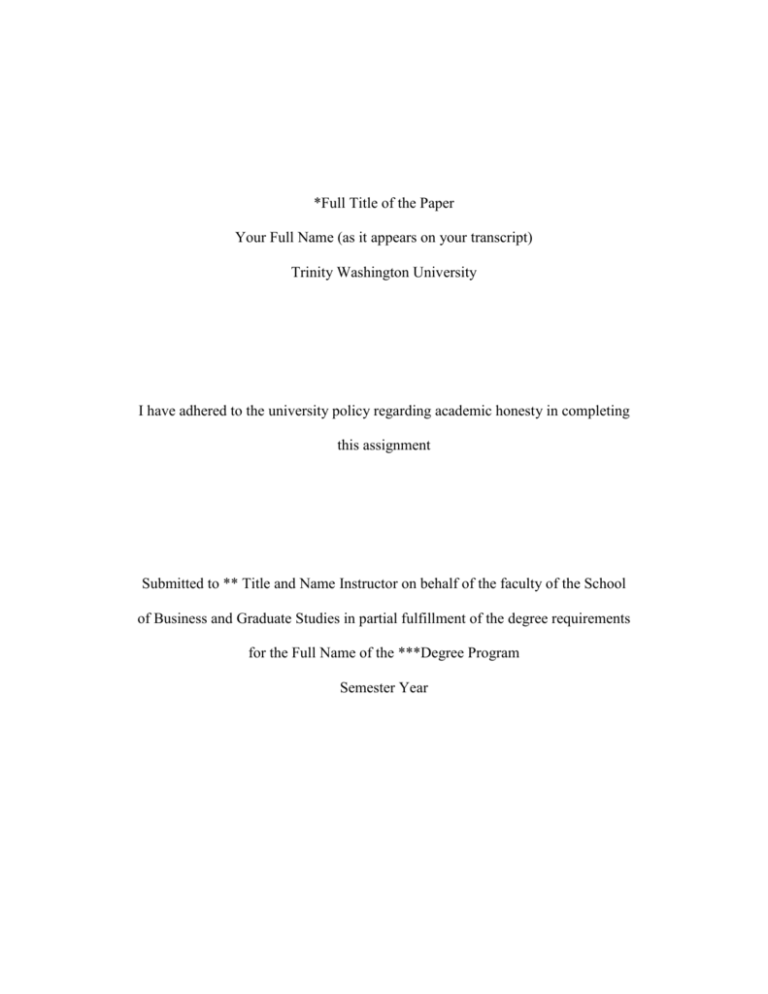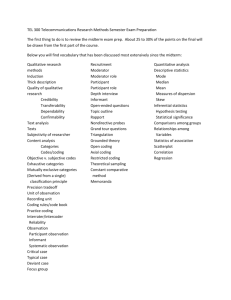
*Full Title of the Paper
Your Full Name (as it appears on your transcript)
Trinity Washington University
I have adhered to the university policy regarding academic honesty in completing
this assignment
Submitted to ** Title and Name Instructor on behalf of the faculty of the School
of Business and Graduate Studies in partial fulfillment of the degree requirements
for the Full Name of the ***Degree Program
Semester Year
QUALITATIVE RESEARCH PAPER
2
Abstract
The abstract consists of 150 to 250 words in a single paragraph, see APA 6th Publication Manual
section 2.04 for guidelines regarding items to be included. After the abstract one the same page
and starting a new paragraph are keywords, in italics, that will assist others in researching
scholarly work related to your topic. Remember there is no indent in this paragraph. Your
instructor may determine the length of the abstract as long as it fits the parameters of no more
than 250 words. The abstract should be comprised of the following sentences:
One to two sentence(s) covering the general context of the research topic
One to two sentence(s) covering the specific context of the research topic
One to two sentence(s) regarding the research problem
One sentence regarding the research methodology (data collection strategy)
One sentence regarding the data analysis strategy
One to two sentences regarding the significant findings (conclusions,
recommendations, implications)
Keywords: Include topic, major theories and theorists, keywords others might use to find
your work, research methods, and data analysis strategy.
*Note that the shortened title header and page number begin here on the second page with page #
2. When you set up your shortened title as the header, do that on the title page, then select different first
page in the header design tab. Also, there should be no lists in an abstract. It is one solid paragraph, two
if necessary. *Acknowledgements or Dedications would each have their own page following the abstract
and before the Table of Contents. *All front matter has regular, not bold, headings and none of the front
matter appears in the table of contents.
QUALITATIVE RESEARCH PAPER
3
Table of Contents
Page
Introduction ..................................................................................................................................... 6
Statement of the Problem .................................................................................................... 6
Purpose of the Study ........................................................................................................... 6
Significance of the Study .................................................................................................... 6
Theoretical Perspective ....................................................................................................... 6
Research Method ................................................................................................................ 6
Assumptions and Limitations ............................................................................................. 6
Summary ............................................................................................................................. 6
Literature Review............................................................................................................................ 7
Sections – there should be several ...................................................................................... 7
*Subject of Case Study ......................................................Error! Bookmark not defined.
Review of Related Research ..............................................Error! Bookmark not defined.
Theoretical Construct .......................................................................................................... 7
Summary ............................................................................Error! Bookmark not defined.
Research Methods ........................................................................................................................... 8
Research Questions ............................................................................................................. 8
Setting ................................................................................Error! Bookmark not defined.
Population ..........................................................................Error! Bookmark not defined.
*Data Source(s) ................................................................................................................... 8
Ethical Considerations ........................................................................................................ 8
Research Design.................................................................Error! Bookmark not defined.
*Intervention Protocol .......................................................Error! Bookmark not defined.
Interview Instrument and Protocol.....................................Error! Bookmark not defined.
Data Analysis Strategy........................................................................................................ 8
Summary ............................................................................................................................. 8
Findings........................................................................................................................................... 9
Participants .........................................................................Error! Bookmark not defined.
Data Analysis and Coding .................................................................................................. 9
Summary ............................................................................................................................. 9
QUALITATIVE RESEARCH PAPER
4
Discussion ..................................................................................................................................... 10
Research Questions ........................................................................................................... 10
Conclusions ....................................................................................................................... 10
Recommendations and Implications ................................................................................. 10
Summary ........................................................................................................................... 10
References ..................................................................................................................................... 11
Appendices .....................................................................................Error! Bookmark not defined.
Appendix A: Recruitment Materials: English....................Error! Bookmark not defined.
Appendix B: Recruitment Materials: Español ...................Error! Bookmark not defined.
Appendix C: Informed Consent Form ...............................Error! Bookmark not defined.
Appendix D: Interview Instrument ....................................Error! Bookmark not defined.
*Use Heading One, primary level heading, for each chapter, and Heading Two for each
secondary level heading (indented 0.5”) for each section within the chapter. Third level and below
headings do not appear in the Table of Contents. The Table of Contents ends with the Appendices section.
Use the MS Word heading function to establish your two heading levels and to edit how they appear in
the document. Then you can use the Table of Contents builder to auto-create the table of Contents.
Microsoft Help in MS Word can assist you with learning this.
QUALITATIVE RESEARCH PAPER
5
List of Tables
Page
Table 1. The coding key for transformative learning .................... Error! Bookmark not defined.
Table 2. Meta-codes: The three aspects of Latina women’s cultureError! Bookmark not defined.
List of Figures
Page
Figure 1. Qualitative theoretical construct as a literature map ...... Error! Bookmark not defined.
Figure 2. Qualitative theoretical construct as a process ................. Error! Bookmark not defined.
Figure 3. Qualitative theoretical construct as a cycle ......................................................................7
Figure 4. Coding chart for conflict emotion charts ........................ Error! Bookmark not defined.
Figure 5. Qualifying interview participants ................................... Error! Bookmark not defined.
*Note: you may place the list of tables and the list of figures on one page, but you should choose
to put them on separate pages if either list is extensive.
QUALITATIVE RESEARCH PAPER
6
Introduction
This is your rhetorical argument leading to the discussion of the research problem below.
See the Argument to Abstract to Introduction document for assistance.
Statement of the Problem
Purpose of the Study
Significance of the Study
Theoretical Perspective
Research Method
Assumptions and Limitations
Summary
QUALITATIVE RESEARCH PAPER
7
Literature Review
The preamble is both an expansion of your abstract and a more concise summation of the
argument in the preamble of the literature review.
Sections
Theoretical Construct
Factor one.
Factor 2. and etcetera.
Academic
rigor
Vague
direction
Complex
assignment
Physical
Stress
Psychological
Sress
Figure 1. Theoretical construct of precedents for plagiarism.
Summary
QUALITATIVE RESEARCH PAPER
8
Research Methods
Begin the chapter with a preamble (a discussion of what will be covered or accomplished
in this chapter and is presented without a subsection heading).
Research Questions
List and then discuss each of the general questions that determine what methods you will
use and what type of data you will collect.
Research question one (RQ1):
Research question two (RQ2):
Research question three (RQ3):
Data Sources
Ethical Considerations
Data Analysis Strategy
Summary
QUALITATIVE RESEARCH PAPER
9
Findings
As in the previous chapters the findings begins with a preamble, a paragraph describing
what will be covered or accomplished in this chapter.
Discussion of the Sample
Data Analysis and Coding
Qualitative methodologies should include three levels of coding to ensure the rigor of
your analysis.
Primary level coding for naming from concepts to categories and then to themes.
Secondary level coding to analyze the relationships between the themes resulting
from the primary level coding.
Triangulation of the resulting combined upper level understanding, based on the primary
and secondary coding, which is compared to the raw data to establish fit and appropriateness.
Summary
QUALITATIVE RESEARCH PAPER
10
Discussion
As in the previous chapters the discussion begins with a Preamble, a paragraph
describing what will be covered or accomplished in this chapter.
Research Questions
Discuss your findings or results in relation to your each of research questions in order of
the questions.
RQ 1: restate the research question.
RQ 2: and so on
Conclusions
Recommendations
Implications.
Summary
QUALITATIVE RESEARCH PAPER
11
References
The references section is written in the hanging indent style and with a sentence space of 1.5 for
improved readability. There must be a reference for every work cited, and nothing
should be referenced that is not cited, in the entire document.
See the APA 6th Publication Manual, chapter 7 for the appropriate reference styles for each type
of source used.
Your reference section should include every work cited in the paper. The reference section of an
APA research paper is unlike a bibliography from other publishing styles. The reference
section of this paper may only include works that you have cited in the document. You
may not include items that influenced you, or are recommended reading, only include
what you have actually cited.
For example,
American Psychological Association, (2009). Publication manual of the American psychological
association (6th ed.), Washington, D.C.: Author
Booth, W. C, Colomb, G.G., & Williams, J. L. (2008). The craft of research (3rd ed.), Chicago,
IL, Chicago University Press.
*Use Chapters 3 to 5 to clarify your topic into questions.
Creswell, J. S. (2014). Research design: Qualitative, quantitative, and mixed methods
approaches. (4th ed.), Thousand Oaks, CA: Sage Publishing
Krippendorff, K. (2006). Reliability in content analysis: Some common misconceptions and
recommendations. Human Communication Research 30(3) 411–433
Krippendorff, K. (2013). Content analysis: An introduction to its methodology. Thousand Oaks,
CA: Sage Publications
Lester, J. D. & Lester, J. D. Jr. (2011). Writing research papers: A complete guide, Upper Saddle
River, NJ: Pearson Longman.
*Use chapter 7, sections F & G to develop an annotated bibliography and turn it into a
literature review.
QUALITATIVE RESEARCH PAPER
Merriam, S. B. (2009). Qualitative research: a guide to design and implementation. Thousand
Oaks, CA: Sage Publishing.
*Use all chapters as they are helpful.
Merriam, S. B. & Tisdell, E. J. (2016). Qualitative research: a guide to design and
implementation. Thousand Oaks, CA: Sage Publishing.
*Use all chapters as they are helpful.
Paul, R. & Elder, L. (2008). The miniature guide to critical thinking: Concepts and tools.
Dillon Beach, CA: Foundation for Critical Thinking.
Remler, D. K. & Van Ryzin, G. G. (2010). Research methods in practice: Strategies for
description and causation. Thousand Oaks, California: Sage Publishing.
Saldana, J. (2009). The coding manual for qualitative researchers. Thousand Oaks, California:
Sage Publishing.
*The appropriate sections for your primary and secondary coding of the data.
Schensul, S. L., Schensul, J. J., & LeCompte, M. D. (1999) Essential ethnographic methods:
Observations, interviews, and questionnaires. In Schensul, J. J., & LeCompte, M. D.
(Eds.) Ethnographer’s Toolkit Lanham, MD: Altamira Press
Schensul, J. J., & LeCompte, M. D. (2013) Essential ethnographic methods: Observations,
interviews, and questionnaires. In Schensul, J. J., & LeCompte, M. D. (Eds.)
Ethnographer’s Toolkit Lanham, MD: Altamira Press
*The appropriate chapter for surveys or interviews.
Shenton, A. K. (2004). Strategies for ensuring trustworthiness in qualitative research projects.
Education for Information 22 63–75
Szafran, R. (2012). Answering questions with statistics. Thousand Oaks, CA: Sage Publishing
Yin, R. K., (2013). Case study research: Design and methods (5th ed.), Thousand Oaks, CA:
Sage Publishing. *The standard for case study research.
12








